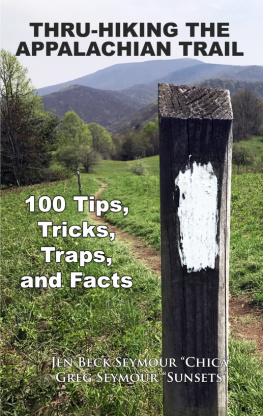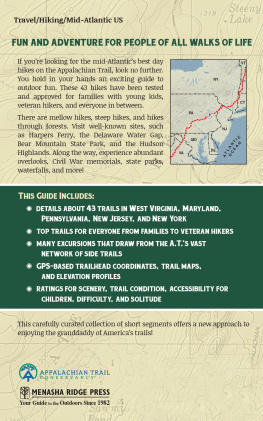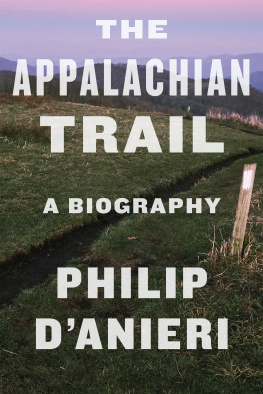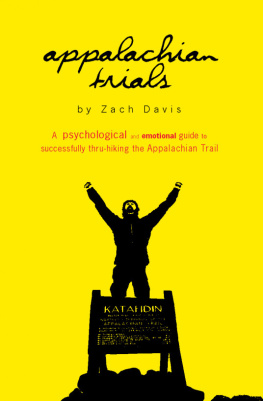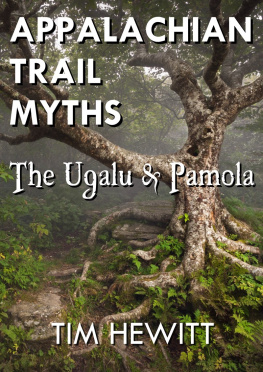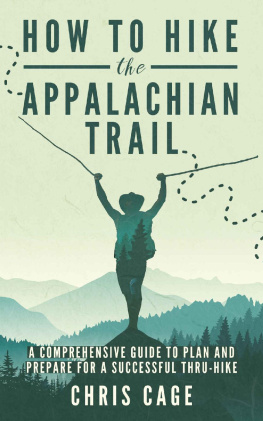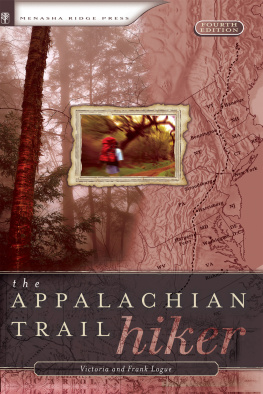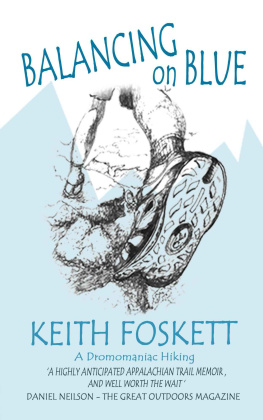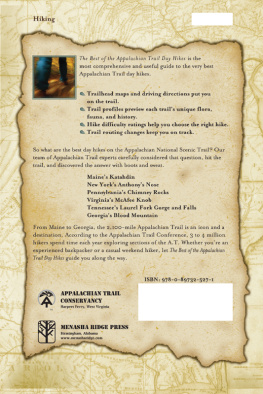THRU-HIKING THE APPALACHIANTRAIL
100 TIPS, TRICKS, TRAPS, ANDFACTS
Jen Beck Seymour Chica
Greg Seymour Sunsets
ALSO BY JEN BECK SEYMOUR
______________
Costa Rica Chica
Life Outside the Cubicle
Costa Rica Chica Cookbook
Grecia, Costa Rica
ALSO BY GREG SEYMOUR
______________
Living in and Visiting Costa Rica
Costa Rica Curious
Copyright 2018 Greg Seymour Jen BeckSeymour
All rights reserved.
All product and company names are trademarksor registered trademarks of their respective holders. Thetrademark holders are not affiliated with the authors of this bookand do not endorse this book.
TABLE OFCONTENTS
INTRODUCTION
HIKER JARGON
I. KNOW BEFORE YOU GO
II. GEARING UP
III. MONEY, MONEY, MONEY
IV. SHELTER ME
V. BODY OF WORK
VI. CREATURE FEATURE
VII. PEEING, POOPING, PERIODS &PRIVIES
VIII. SPECIFIC SPECIFICATIONS
IX. FUEL & MAINTENANCE
X. LOOSE ENDS
XI. WHATS STOPPING YOU?
CLOSING
BONUS GEAR LISTS
INTRODUCTION
So, have you read AWalk in the Woods?
This question inevitablywas asked of us when we informed friends and family we were goingto hike the Appalachian Trail (AT). This, of course, isinterchangeable with the book Wild( even though Wild takes place on the oppositecoast of Brysons account). And, why not? These two tales of longdistance walking on a whim captured the worlds attention andhave convinced many that the pursuit is feasible foreveryone.
Indeed, the two books areamong the reasons completing a thru-hike (hiking a whole trailwithin 12 months) occupies a high position on the bucket lists ofmany angling to amble in the wilderness for several months. This,despite the fact neither author completed their thru-hike of theAppalachian Trail or the Pacific Crest Trail, respectively.However, we did .
Our journey on the Appalachian Trail through 14 states and over 2,189.8 miles started at AmicalolaFalls, Georgia on March 22, 2017 and ended on Mount Katahdin, Maineon September 16, 2017.
We were a peculiar demographic to completethe epic journey. First, we hiked in our mid-40s while the majorityof long-distance wanderers were much younger with most in their20s. Secondly, we were a couple, and there were very few of theseanimals on the trail. Its hard enough for a single person to dodgeailments, injury, and the emotional toll of the trail, let alonetwo to finish together. Thirdly, prior to our hike, we had notspent more than three consecutive nights in a tent ever. So, onpaper we were unlikely to complete the trail in one go. But we beatthe odds and finished together.
The percentage of finishers is in flux fromyear to year. Typically, only 25-30% of those who start hiking thetrail with the intention of completing the entire trek in a12-month period complete it. We went from backpacking neophytes toexperts in the span of 179 days.
The purpose of this bookis to pass along some of the knowledge we gained during ourthru-hike to help you successfully plan and implement your hike.
Thru-Hiking theAppalachian Trail 100 Tips, Tricks, Traps, and Facts is not meant to be a comprehensive guide. Rather,we will provide an overview of the trail, as well as some of theminutia that leads to a successful completion.
Writing a book together is not the same ashiking together. To keep the peace, we split up the chaptersbetween us, so we each have our own unique voice. We designate whowrote which chapter in the chapter title. Also, keep in mind whenreading our stories or while considering the geography that wethru-hiked the trail NOBO (northbound) from Georgia to Maine.
Following this introduction is a list oftypical slang terms used by the thru-hiking community. Beginning inchapter one, the first use of each term will be shown in quoteswith a brief parenthetical definition.
Not only will you learn about the AT andwhat life is like on the trail, but you will also learn tips forbudgeting, planning meals, dealing with bears and other pests,following park regulations, selecting gear, and oh, so muchmore!
We documented our trip, almost daily, on thefollowing social media platforms:
YouTube.com/AppalachianTrailTales
AppalachianTrailTales.com
Facebook.com/AppalachianTrailTales
Instagram.com/AppalachianTrailTales
Please follow us on the above social mediapages as we continue to explore the AT and other long trails in theU.S. and abroad (up next, the Camino de Santiago in Spain).
Hiking the Appalachian Trail can belife-changing. It certainly changed ours. Knowledge, a sense ofadventure, a healthy dose of humor, and endless tenacity are allneeded to complete this epic journey. Good luck with your research.We wish you the best for your journey on the Appalachian Trail, andas the saying goes:
The journey of a thousandmiles begins with a single step.
~Lao Tzu
Rock On and Walk On,
~ Sunsets & Chica
HIKERJARGON
Hikers on the Appalachian Trail are adistinct community with their own culture. For instance, hikers goby nicknames instead of their real names, hitchhiking happens allthe time, and sharing hotel rooms with virtual strangers is thenorm, as is going without a shower for days. Alongside thisdifferent lifestyle is a unique jargon used among hikers, which youwont find in any dictionary. Heres our version of the most-heardwords on the trail and their meanings.
2,000-Miler: A term used by the ATC to signify a thru-hiker even though the complete distance, which changes every year, islonger than 2,000 miles.
ATC: The Appalachian Trail Conservancy, a nonprofit organizationdedicated to the conservation of the Appalachian Trail.
AT Guide (Awol's Guide ): The most-used guidebook on the Appalachian Trail, comes ine-book (pdf) and paper-book format (northbound or southbound, boundbook or loose-leaf), by David Awol Miller.
Bear bag: Bag used for food and anything that smells, whichis hung every night out of reach of bears and otheranimals.
Blazes: There are several different blazes along theAppalachian Trail, both physical (blazes) and metaphorical(blazing):
--White blaze: A 2 x 6 vertical rectangle painted on trees,rocks or signposts showing the way on the AppalachianTrail.
--Double whiteblaze: Two white blazes, one above theother, signify an intersection or turn coming up. Two offset whiteblazes indicate a turn coming up, turning in the direction of thetop blaze.
--Blue blaze: A 2 x 6 vertical rectangle on trees, signifyingtrails leading off the Appalachian Trail going to shelters, watersources, views or bad-weather routes.
--Yellow blazing: Bypassing parts of the Appalachian Trail by road(the yellow comes from the middle yellow line of theroad).
--Aqua blazing: Bypassing parts of the Appalachian Trail bycanoe, boat or kayak, typically through the Shenandoah NationalPark section of the AT.
--Deli blazing: One who tries to hit all of the delis (especiallyin NJ and NY) along the Appalachian Trail.
--Green blazing: One who smokes (marijuana) their way up the trailhaving frequent safety meetings with fellow greenblazers.
--Pink blazing: A male thru-hiker trying to catch up with afemale thru-hiker by clues left in the shelter traillogs/journals.
--Banana blazing: A female thru-hiker trying to catch up with amale thru-hiker by clues left in the shelter traillogs/journals.
--Silk blazing: Being the first hiker on the trail in the earlymorning usually means you are clearing all the silk (spider webs)from the trail.
Blow-down: Tree or limb that has fallen across thetrail.
Bounce box: A box you use and keep sending ahead from postoffice to post office ( i.e., might contain a large bottle ofpainkillers, etc. , that you only want to carry a small of amount of on thetrail. You take a handful for your next days out in the woods andsend the large, heavy bottle forward).
Next page
